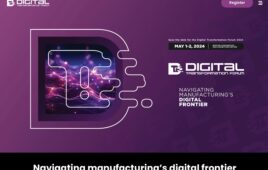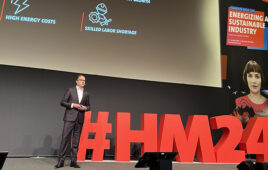Rexnord, a Milwaukee-based manufacturer of bearings, couplings, gear drives and related engineered products, recently previewed its vision of the Internet of Things (IoT) at the MINExpo show in Las Vegas.
According to company officials, the goal is to add IoT capabilities to power-transmission systems and give operations professionals real-time data, analysis and feedback—resulting in better machine performance and longer product life. The expansion into “connected” technology is expected to have an across-the-board impact on Rexnord’s broad line of PT offerings.

Rexnord’s IoT-capable power-transmission system was on display at MINExpo in Las Vegas.
“The concept involves bringing the Internet of Things to the mechanical world,” said Mike Miclot, vice president of commercial marketing. Examples include gearboxes fitted with sensors and indicators that monitor critical performance parameters like vibration, oil condition, temperature, load and speed.
While mounting sensors on gearboxes isn’t new, the Rexnord platform offers several significant differences. For one, current users in need of condition-monitoring capabilities tend to retrofit equipment with add-on components like vibration sensors. Such devices often get mounted for convenience, in locations ripe for physical abuse and less-than-ideal for data pick-up and transmission. The Rexnord system, in contrast, is a comprehensive factory-installed design that tracks all the customer’s critical measurements, with high-integrity sensors best located to withstand heat, vibration and contamination, explained Miclot.
Also, sensor output is transmitted not just to the local machine controller, but to higher level enterprise-type Manufacturing Execution Systems (MES). This cloud-based system will offer remote access to real-time data in an easy-to-use format for diagnostics, analytics, equipment-effectiveness reporting and similar applications. Overall, this makes it easier for Rexnord to support customers and products with unique feedback and system-monitoring capabilities. The end results, said Miclot, are less unplanned downtime, faster maintenance and repairs, and better optimized asset management.
On the MINExpo show floor, Miclot demonstrated the IoT/PT set-up with a controller tracking sensor data and providing an internet signal to the asset-management software, which in turn generates predictive machine “intelligence” as well as reactive commands.
For example, routine measurements like elevated oil-contamination levels will trigger the machine’s Andon indicator light and signal the control room to schedule maintenance. “It’s different from the clipboard methodology where a machine is serviced every three months, on a set time cycle,” he said. Instead, it’s need-based and measures actual environmental conditions and gives a more-precise window of when to replace the oil. “Otherwise, either you’re performing excessive routine maintenance, which is costly, or you’re rolling the dice, waiting too long and approaching something more catastrophic.”
In another case, sensing a sudden critical fault, such as misalignment-induced vibration, illuminates a machine warning light and alerts the control room to take immediate action—like reducing the load or shutting down the equipment. At the same, it reports the exact machine, its history, the type of fault and service procedures to a maintenance provider that, in turn, can dispatch a repair technician already armed with the necessary replacement parts and tools. “Once again, MTBF and MTTR are optimized because we’ve prevented a catastrophic fault and service shows up with exactly what’s needed to quickly make that repair,” said Miclot. “Frankly, we already have experienced and capable service crews. It’s taking our existing service model and really putting it on steroids, and ultimately using all this information to better serve our customers.”
“Conceptually we’re not just spewing data. We have sophisticated software that actually tells you in human-readable language what the issue is, and the suggested actions to take. We’re actually communicating information instead of just data,” he emphasized.
Rexnord has a number of power-transmission test set-ups running at customer sites, and they’re currently collecting real-time data, tuning algorithms, and proving out the overall system, Miclot added. The company will start to roll out products with IoT capabilities in 2017.
Rexnord Corp.
www.rexnord.com
Filed Under: IoT • IIoT • Internet of things • Industry 4.0, Gears • gearheads • speed reducers





Tell Us What You Think!